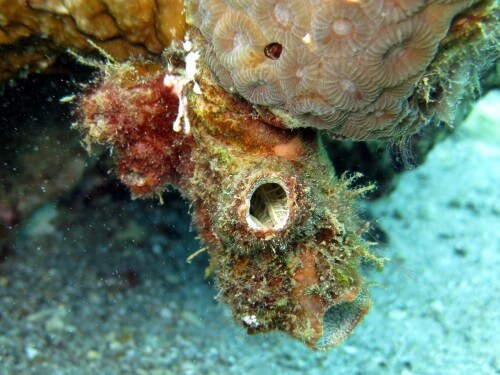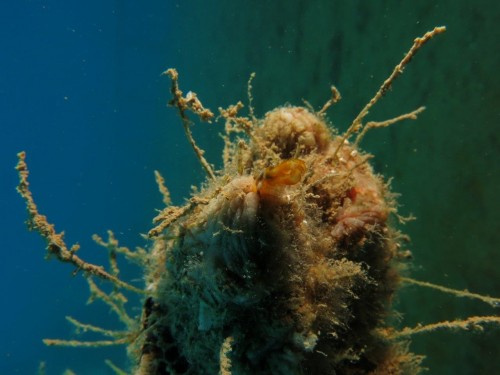Researchers from Tel Aviv University discovered in the waters of the Gulf of Eilat a new marine creature that knows how to eject its entire digestive system in times of danger, stay alive and then rebuild it Is it possible that we have found a key to regenerate vital organs in humans as well? The article was published this weekend in the journal Scientific Reports from the Nature group

Scientists and doctors all over the world are showing great interest in the topic of cell and organ regeneration, in the hope that a way will be found to rebuild organs that have been damaged or removed from our bodies. Dr. Noa Shankar and student Tal Gordon from the Department of Zoology at Tel Aviv University recently discovered a small and simple-looking marine creature that is able to do this completely naturally: it is the polycarpa type of istellan, which in response to light mechanical pressure ejects its entire digestive system, and in a short time repairs the damage, and builds himself a new digestive system.
"Many animals are able to regenerate lost limbs," says Dr. Noa Shankar, a marine biologist from the Department of Zoology at Tel Aviv University, who serves as curator of the marine invertebrate collection at the Steinhardt Museum of Nature, which operates at the university and contains the national collections of all living species in Israel. "For example, lizards regenerate their tails, starfish regenerate arms, and flatworms regenerate whole body parts, but all these organs are not essential for the survival of the animal. The Iztelan, on the other hand, is able to expel the entire digestive system - a critical organ without which there is no life, survive without it for a certain period of time, and in the meantime rebuild it. It seems that man has a lot to learn from this little creature, which hides on coral reefs in the sea."
The research was carried out in collaboration with master's student Tal Gordon, and was published on March 16, 2015 in the journal Scientific Reports, which belongs to the Nature group.

Intestinal regeneration within 12 days
"As part of our work, within the framework of the Taxonomy Initiative in Israel, we are conducting surveys of marine invertebrates known as stilts, which live in the coral reefs in Eilat," says Dr. Shankar. "That's how we found out that a certain species of Etzlan emits something when we try to sample it. Further examination revealed that the ejected bone is actually the digestive system of the Itztelan." An in-depth historical investigation revealed that naturalists who worked in Europe at the end of the 19th century were already familiar with the phenomenon - but none of them investigated the essential question: Did the Iztelan remain alive after the extreme act?
In order to document and investigate the issue in depth, the researchers took a number of sea urchins to the laboratory, made them eject their digestive system in response to light mechanical pressure, and made observations. They discovered that immediately after the emission, the istella contracts very much, and even closes for 48 hours, but gradually it recovers, opens and returns to normal function. "We realized, to our astonishment, that the acetylenes carry out a miraculous process of tissue regeneration and repair," says Dr. Shankar. "In another test, we found that they regenerate the intestine within 12 days, while another part of the system, a food filter called the gill basket, regenerates within 19 days. It's really science fiction!”
Protection from potential predators
Why does the Iztelan take such an extreme step? It turns out that the release of the digestive system and its renewal are a central component of a highly effective survival mechanism - since the specific species that is able to do this is a highly successful and prosperous species. In fact, out of about 3,000 recognized species of estalani in the world, this is the most common species in the coral reef in Eilat, and among the most common in reefs in the entire world.
"This Itzetlan is well camouflaged on the reef," says Dr. Shankar. "Its color is brown, and it is usually covered with other types of creatures. It itself is not usually used as food for fish - as its taste is not a guarantee of its quality. In one of our experiments, we removed 18 digestive systems that ejected stilts to hungry reef fish, and the result was uniform: the fish put the offered 'food' into their mouths, and immediately ejected it. We still don't know what the ingredient is that creates the bad taste, it's possible that it protects the Iztelans from potential predators." Now the researchers believe that in nature the itzalan emits the digestive system when a fish that is interested in the creatures growing in its environment accidentally bites it too. According to them, it may be a diversionary action, and perhaps this is how he signals to the predator: 'Don't touch me. don't eat me I'm not tasty'.
closest to man
Beyond the zoological aspect, which is fascinating in itself, the new discovery has an extremely important applied potential in the field of medical research. "The bowel evacuation phenomenon is very well known from sea cucumbers. But the Iztelans already belong to the Mitharani system," explains Dr. Shankar. "Among all the invertebrates living in the sea, the ichthys are evolutionarily the closest to vertebrates - including mammals and humans. Many features, systems and processes in the body have hardly changed during evolution - and in fact the intestinal tissues and digestive system of the Itztel, as well as the cell regeneration process that takes place within it, are very similar to ours. Therefore, the Iztelans, which are common and available animals, can be used as an excellent model animal for future medical studies on the subject of soft tissue regeneration."
Now the researchers want to expand their work with the Iztelans. As part of the planned research, they will increase the sample in the coral reef in Eilat, follow closely, day by day, the regeneration process, and examine a selection of interesting questions such as: at what age are the creatures able to eject the digestive system and grow a new one? And is Atalan, who has already renewed his digestive system once, able to do it again? In addition, they will search for collaborations with scientists from the fields of cell research and biomedicine, who will be able to examine in depth the wonderful regeneration mechanism of the Israelis. "We believe that such studies will be able to advance the understanding towards the future development of human organ and tissue regeneration processes," concludes Dr. Shankar.

2 תגובות
Yahassas
It seems that instead of fighting this creature developed a new coping strategy. Perhaps in the style of "transferring the fighting to the enemy's territory". Maybe like the opossum that instead of running away or fighting, pretends to be dead. By keeping the law: instead of fighting drugs, regulating use - tax collection + age limit. Or if they want to fight against illegal hunting, they will release hunting animals. That is, instead of hunting partridges or porcupines, they will hunt the hunting pheasant and the noble elk for example. You can be creative in different issues!